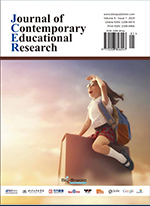Abstract
From the perspective of situational communication, this paper aims to explore how to promote cultural integration and provide better educational services for international students in China. This paper first analyzes the basic assumptions and key factors of situational communication based on international students in China. Secondly, the relationship between situational communication and cultural integration and educational services for international students in China is discussed in depth. Additionally, the role of situational communication in educational services for international students in China, such as promoting cross-cultural communication, solving language barriers, and enhancing mutual understanding, is proposed. Lastly, from the perspective of situational communication, an optimization path of educational services and cultural integration for international students in China is proposed, including the provision of diversified educational resources, the enhancement of cross-cultural communication, and the establishment of an effective communication mechanism. This study expands the perspective of educational services for international students in China, provides a new theoretical framework and practical path, and offers a reference for promoting cultural integration and improving educational services for international students in China.
References
Hall ET, 1959, The Silent Language, Doubleday Company Inc., New York.
Gu Q, Schweisfurth M, 2011, Who Adapts? Beyond Cultural Models of “the” Chinese Learner. Language, Culture and Curriculum, 24(3): 273–289.
Jia G, Li M, 2018, Challenges and Coping Strategies of International Students Studying in China: A Systematic Review. Higher Education Research & Development, 37(5): 925–940.
Liu Y, 2017, Management and Support of International Students in China: A Case Study. Journal of International Students, 7(4): 1003–1017.
Wang X, Han Y, 2020, Chinese Education for International Students: Challenges and Opportunities. Chinese Education & Society, 53(1): 1–7.
Zhao S, Cheng Y, 2018, The Interplay Between Academic Stress and Cultural Identity Among International Students in China. Asia Pacific Education Review, 19(4): 523–533.
Zhang L, 2014, The Essence of Higher Education for International Students in China. Journal of Studies in International Education, 18(4): 305–323.
Cheng L, 2012, The Nature and Purpose of Chinese Education for International Students. Journal of Research in International Education, 11(3): 231–242.
Han X, 2018 Education for International Students in China: A Critical Review. Journal of International Students, 8(3): 1155–1169.
Chen H, Chen D, 2016, Understanding the Essence of Chinese Education for International Students: A Case Study of Zhejiang University. Frontiers of Education in China, 11(3): 318–347.
Yan Y, 1997, The Role of Contextual Factors in Communication. Language Research, 1997(3): 29–34.
Ma R, 2004, Situational Language Teaching in Cross-Cultural Communication. Foreign Language Teaching and Research, 2004(2): 84–86.
Huang W, 2007, The Role of Context in Cross-Cultural Communication. Language Teaching and Research, 2007(1): 54–57.
Luo W, Zhang J, 2008, Exploring Language Teaching Strategies in Cross-Cultural Contexts. Language Education Research, 2008(1): 26–29.
Li Y, Ma J, Shi J, 2010, The Application of Situational Factors in Foreign Language Teaching. Modern Foreign Language Teaching, 2010(3): 46–49.
Chen Q, 2013, Research on Situational Teaching Methods in Intercultural Communication. Foreign Language Teaching and Research, 2013(3): 22–25.
Zhang R, Wu X, 2014, Situational Communication and Language Teaching. Modern Chinese, 2014(6): 15–16.
Qiu J, 2016, The Application of Contextual Factors in Interpreting Teaching. Foreign Languages and Their Teaching, 2016(1): 97–100.
Wang D, Wang X, 2017, The Application of Contextual Factors in Translation Teaching. Foreign Language World, 2017(2): 125–128.
Liu L, Wei J, 2018, Research on the Application of Contextual Teaching in Chinese Language Teaching. Modern Chinese, 2018(5): 81–83.
